
Volkswagen ID.5 review

Introduction
The Volkswagen ID.4 has been a success for VW, encouraging customers to go electric with its approachable style, practical interior and high-tech cabin. But now VW is attempting to increase the scope of the ID.4’s appeal by introducing the ID.5 – essentially a coupe version of the family SUV with a sloping fastback rear and a somewhat sportier demeanour.
Of course, there’s slightly more to building a coupe-SUV than that, but the ID.5 still shares plenty with the ID.4 that spawned it. So has the transition from conventional family bus to more style-conscious fastback really improved the big VW. Or has it simply taken a once-practical family car and spoiled it?
Select's rating score* - 3.3 / 5
At a Glance
From the first glimpse of the ID.5, its heritage is immediately obvious. From the front, it’s pretty much identical to the ID.4 that spawned it, and the whole front end is much the same as before. It’s only really the space behind the driver’s door that has changed, but the difference is noticeable. Where once there was a streamlined but relatively conventional SUV rear end, there’s an unmistakable fastback-style rear window with a big wing.
Inside, though, the difference is much harder to spot – at least from the driving seat. The ID.5 has the same clean, modern interior as its sister car, and it’s dominated by two screens. One is attached to the steering column and shows you all the data you’d normally get from an instrument cluster, while the other is a big touchscreen mounted on the dashboard. Otherwise, it’s standard VW electric car stuff, so the materials are generally good and although build quality is not what it once was, the ID.5 is still as solid as any of its rivals.
It also has plenty of range, with every model currently on sale getting the 77kWh battery pack. That means there’s a maximum range of up to 327 miles on the official efficiency test, making the ID.5 a leader when it comes to long-distance electric motoring.
Of course, you won’t always achieve such range on the motorway or in cold weather, but there’s more to the ID.5 than just range. Depending on which version you choose, you get either 174hp, 204hp or 299hp from the electric motor(s), offering ample straight-line speed. Unfortunately, the car doesn’t ride as well as we were hoping, though, with a slight stiffness over potholes as the suspension tries to both control the inertia of the battery pack and limit the impact of imperfections in the road surface.
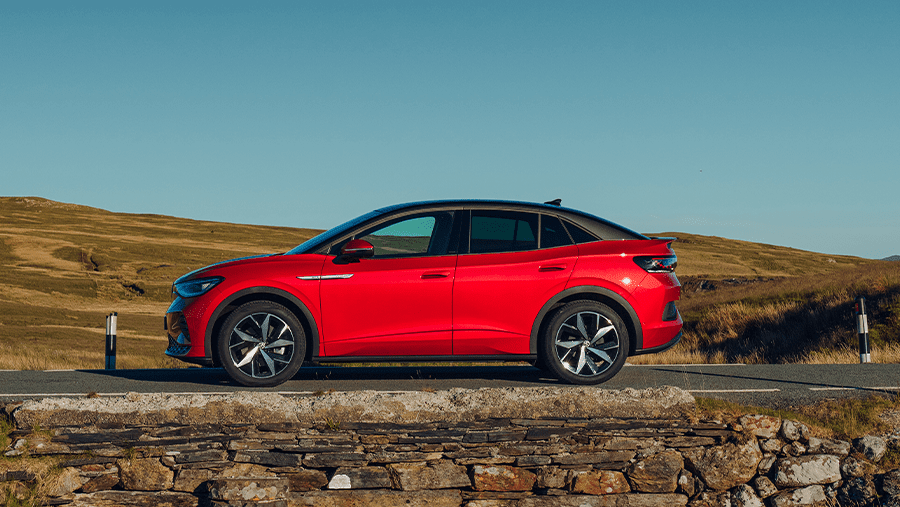
Key Features
The ID.5’s appeal is down primarily to its shape. The fastback-style rear end is intended to make the car more interesting and exciting than its more conventionally shaped sibling, the ID.4, giving it more sway with image-conscious customers. And although there’s a slight practicality penalty for choosing the fancy body shape, it’s nowhere near as apparent as you might imagine.
But for all the ID.5’s design features, it’s hard to talk about any electric car’s appeal without mentioning the range or the size of the battery. With a 77kWh lithium-ion battery pack fitted as standard, the ID.5 is capable of up to 327 miles on a single charge, which makes it one of the better electric cars for long-range motoring. However, our tests suggest such a range will be hard to achieve on a single motorway journey, and something in the region of 200 miles is much more realistic. You can find out more about how that range will translate into your driving habits by taking a look at our guide on official v. real-world battery range.
Nevertheless, compared with other cars in the class, that’s highly competitive.
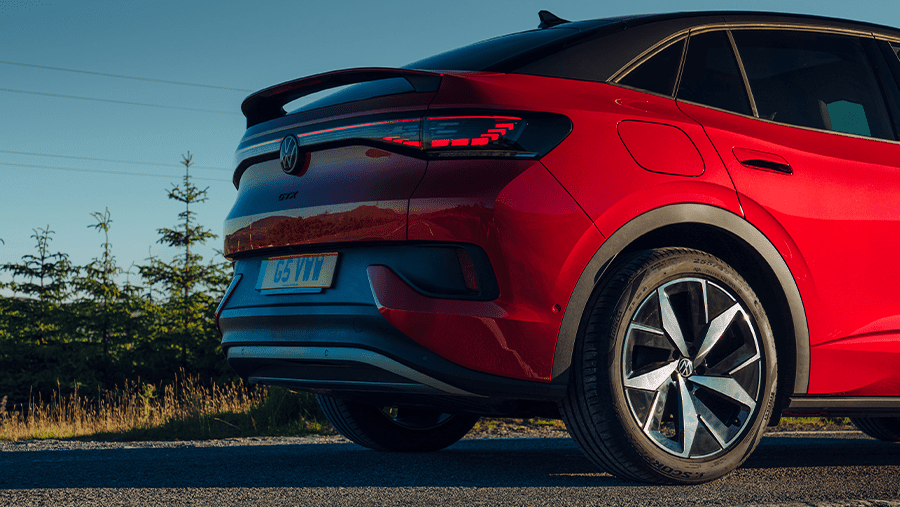
Range & Battery
The ID.5 is currently only available with one battery pack. The 77kWh unit ensures every model offers customers an official range of more than 300 miles on a single charge, but it does vary somewhat depending on which version you choose. The basic Pro and mid-range Pro Performance models, with their single, rear-mounted motors, both manage 327 miles between trips to the plug, while the GTX 4Motion, which has a motor on each axle, cuts that range slightly to 314 miles. Naturally, you’ll struggle to achieve that on a long motorway slog – high speeds are the enemy of battery efficiency – but over a mixture of traffic conditions and roads you might get something over 250 miles without trying too hard.
Performance & Drive
How your ID.5 performs will depend largely on which version you choose. The basic Pro model has a single 174hp motor driving the rear wheels, which means it’s good for 0-62mph in 10.4 seconds. That’s respectable and it’s more than enough for most drivers’ needs, but it isn’t brilliant in the world of electric cars. That said, the ID.5 feels faster than that thanks to its instant access to all the motor’s torque. It’s more than fast enough to nip around in town.
Upgrading to the Pro Performance ups the power to 204hp without damaging range at all, and that means you get more straight-line speed. The sprint from 0-62mph takes just 8.4 seconds, which is much more competitive in the market, and makes the car feel properly fast for something so large.
The GTX 4Motion is the daddy, though, using two electric motors – one on each axle – to offer 299hp and all-wheel drive. That means the 0-62mph time falls even more dramatically, hitting a truly sporty 6.3 seconds. That means it accelerates about as quickly as the smaller, lighter Volkswagen Golf GTI.
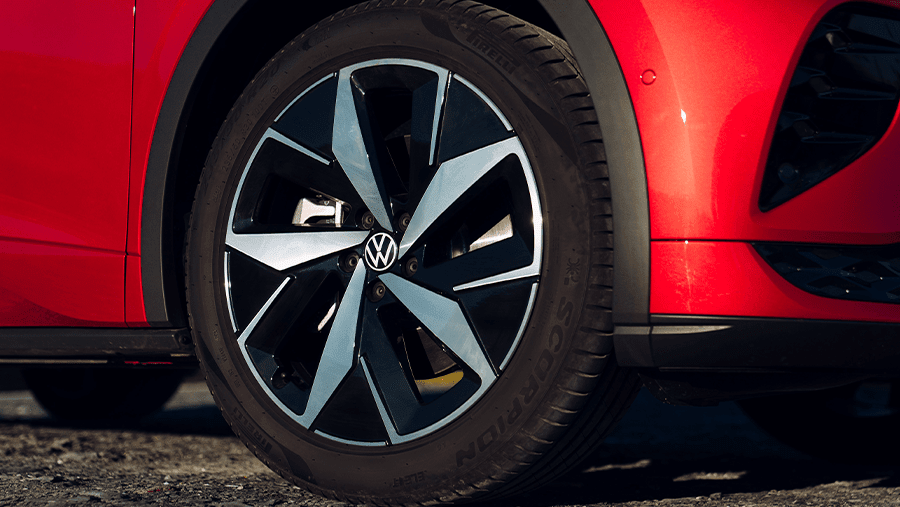
Whichever ID.5 you choose, though, the focus will not be on sporty driving. Although the car has a snazzy rear end and some powerful motors under the skin, it’s only really fast in a straight line. Sure, it hangs on well enough in corners – there’s plenty of grip on offer – but the body rolls quite alarmingly thanks to the soft suspension and tall body. If you want something more sporty, try the ID.3 hatchback, or even the more conventionally powered Golf.
Normally, the advantage of such handling qualities (or lack thereof) would be counterbalanced by a smooth ride, but the ID.5 doesn’t impress in that area either. Of course, it’s tolerable – you won’t get your teeth shaken out – but it isn’t as comfortable as we were hoping it would be. It’s particularly stiff at low and medium speeds, where the weight seems to drag it down into potholes, but it does improve slightly in a motorway cruise.

Charging
Assuming you can find a free, fully functional 150kW charging point, filling an ID.5 will be a relatively painless affair. With the ability to charge at up to 135kW, the ID.5 will get to 80% charged in less than half an hour, but charging from a domestic ‘wallbox’ home charging unit will take considerably longer. You can find out more about how to pick your ideal electric car charger in our guide.
Filling the battery completely will take 12 hours and 40 minutes, although you can shorten that to seven hours and 30 minutes if you can use an 11kW, three-phase charger.

Running Costs & Emissions
Despite the cost-of-living crisis, running an ID.5 will still be cheaper than running pretty much any other comparable SUV – especially for those who charge at home. Yes, the cost of charging elsewhere is on the up, but membership of charging networks should keep those costs to a minimum. And, because of government incentives on electric cars, they work out cheaper to tax than equivalent petrol and diesel vehicles.

Interior & Technology
The ID.5’s cabin is more or less identical to that of the ID.4 – certainly from the driving seat. That means you get the same clean, modern design dominated by two screens: a digital instrument display and a massive touchscreen. The former is small but sharp, giving you a basic overview of the important data – charge, range, speed and the like – while the latter is more of a problem child for VW.
We had no problems with the system in our test car, but VW has been having issues with its latest-generation touchscreen tech over the past couple of years. Hopefully, VW has got all that behind it, and the system will prove more stable in future, but it still won’t be perfect. With fussy, complicated displays and hidden menus, it’s an ergonomic nightmare that’s really awkward to use on the road. It feels as though it was designed on an iPad and never tested in a car.

That said, other aspects of the ID.5’s tech offering are very good. The head-up display is very sharp and well thought through, and while the idea of never needing an ignition button is a bit alien at first, it works quite well thanks to the microswitch in the driver’s seat. And for those still worried about the touchscreen, you can always connect your phone and use the more user-friendly Apple CarPlay and Android Auto smartphone integration technology.
Tech aside, VW has a reputation to uphold when it comes to quality, and though the ID.5 is not a cheap car – base models start at just over £50,000 – the coupe-SUV is not the brand’s finest showing. Everything feels well engineered and most of the materials are very good, but there are some odd choices in there, particularly with regards to cabin plastic in the doors and some of the sharp edges on the dash. The column-mounted gear selector feels a little cheap, too.

Practicality & Boot Space
The ID.5 has a 549-litre boot as standard, making it slightly less capacious than the Skoda Enyaq Coupe, but it has a little more space than the Audi Q4 Sportback e-tron. More to the point, though, it has marginally more boot space than an ID.4, despite the sloping rear window. That’s because boot space is only measured to the window line, so although the figures suggest the ID.5 is more spacious, that isn’t entirely true. When you fold the back seats down it ends up having less space, and the boot isn’t quite so good at carrying awkward, bulky objects.
Nevertheless, the ID.5 doesn’t carry too much of a practicality penalty compared with the ID.4. There’s ample rear legroom for adults and although the roofline is sloping, there’s still enough headroom for most passengers. Only the very tallest will really struggle, so the ID.5 still works as a family car. And with a panoramic glass roof as standard, it never feels too claustrophobic back there.
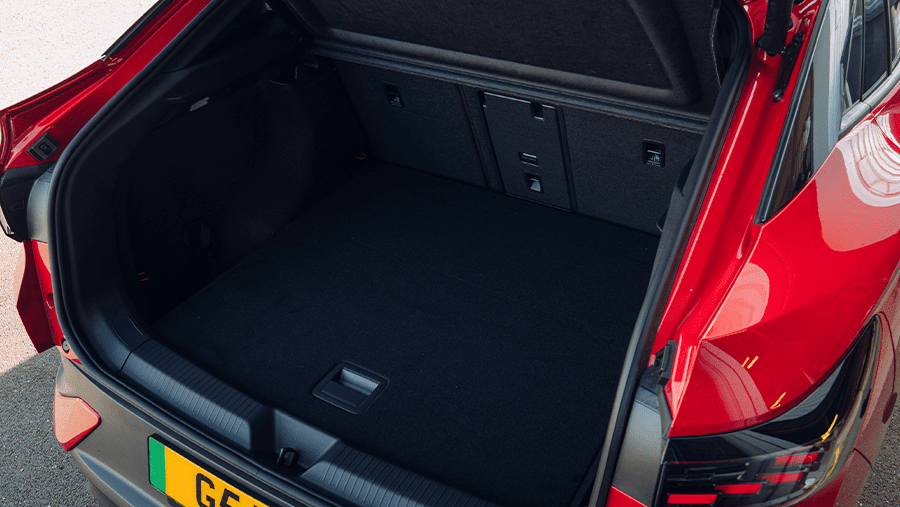
Safety
The ID.5 is a remarkably safe car, having achieved a five-star rating in the Euro NCAP crash test. Particularly impressive was the adult occupant protection score of 93%, although the child occupant protection score of 89% and the safety tech score of 85% were not so far behind.
That’s partly down to the high level of safety equipment fitted to the ID.5 as standard, with all models getting the autonomous emergency braking technology that can stop or slow the car automatically if the driver fails to respond to a hazard such as a stopped vehicle or a pedestrian who has stepped out into the road. Speed assistance technology is also included across the range, as is lane departure warning.
All ID.5 models also come with front and rear parking sensors and a rear-view camera, too, helping to reduce the likelihood of low-speed crashes. Moving up the range gets you a head-up display and a 360-degree manoeuvring camera, both intended to improve visibility on the road.

Options
ID.5 customers get nothing if not choice. Not only do you get to choose between three different motor systems, but each comes with its own trim levels. The basic ID.5 77kWh Pro and mid-range Pro Performance both come with a choice of Style, Tech and Max trims, with all three trims getting alloy wheels, three-zone climate control and a reversing camera, as well as a panoramic glass roof and front and rear parking sensors. The Tech, however, adds power seat adjustment for both front seats, a 360-degree manoeuvring camera and the head-up display, as well as an electrically operated tailgate. Max models, meanwhile, get larger 20-inch alloy wheels, a heat pump and adaptive chassis control allowing drivers to change the ride and handling of the car to suit prevailing conditions.
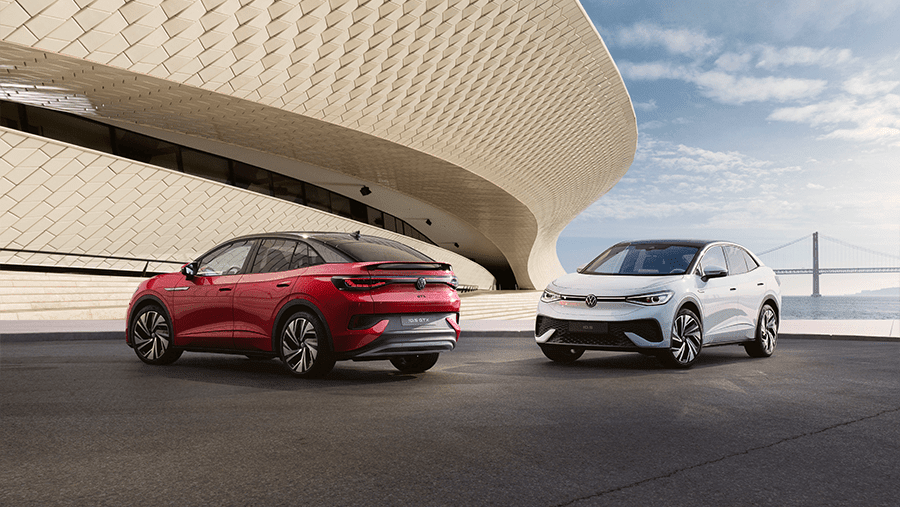
The range-topping, go-faster GTX model is currently only available in Style trim, but it stll comes with its own GTX design and with its own upholstery, while the panoramic roof, three-zone climate control and rear-view camera are all thrown in. It also gets 20-inch alloy wheels, as well as all the standard safety equipment.
Beyond trim levels, the main options essentially come down to colour schemes. Two-tone schemes with a black roof are available, but the body colours are largely limited. There’s a striking Blue Dusk paint option, though, which should play well with customers.
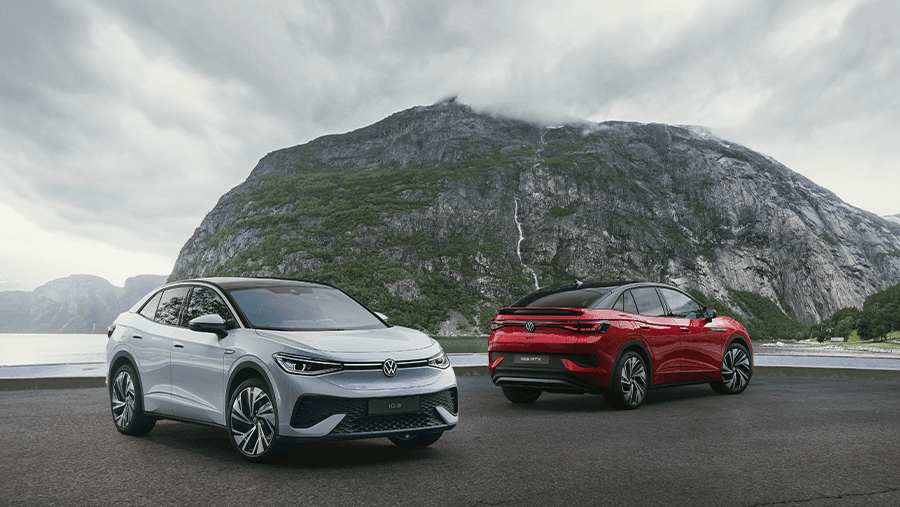
Rival Cars
With the electric car market still in its childhood, if not exactly its infancy, the ID.5 doesn’t have too many rivals to worry about. But it has kept its enemies close, with sister companies Skoda and Audi offering the nearest alternatives to the ID.5. Those cars are the Enyaq iV Coupe and the Q4 Sportback e-tron, both of which share much with the VW.
Yet despite their similarities, the three cars all have very different characters, with the Enyaq built to offer style, practicality, and value, while the Volkswagen is supposed to be a much more upmarket item. That said, both have plenty of quality on display, and the Enyaq’s no-nonsense interior has won it plenty of fans. We aren’t sure about the illuminated grille, though – the ID.5’s simple light signature is much more visually appealing.

The Q4 Sportback e-tron is similar, but it’s even more premium than the VW, as you’d expect from the Audi badge. That said, it comes with a higher list price and that makes a difference to lease rates, so that’s always worth considering when comparing deals.
If you cast your net a little wider, other players such as the Kia EV6, Polestar 2 and Hyundai Ioniq 5 come into play as alternatives to the ID.5, but none is quite as high-riding. All three are great cars, though, and the Kia in particular is great fun to drive, even though it’s much bigger than it looks in photographs.

Verdict & Next Steps
The ID.5 is a bit of a one-trick pony. If you prefer the coupe look to that of the more conventional ID.4 and you absolutely must have a VW electric SUV, it’s the only place to turn, but we’d prefer to drive either the Skoda Enyaq Coupe or the Audi Q4 Sportback e-tron. It’s a bit of a white good, but if you just want an electric car and you don’t care which one you have, then the ID.5 won’t be for you anyway. It’s not that it’s a bad car, it just doesn’t seem to have much of a unique selling point.
Where to next?
View our latest Volkswagen ID.5 Leasing Deals - from just £546.43 per month inc VAT**
Looking for a great leasing deal? Check out our incredible range of Special Offers
New small SUV? Read our latest Car Reviews and find the right model for you
Want to know more about leasing? Take a look at our comprehensive Leasing Guides
Interested in everything motoring? Why not catch up on all the latest Car Leasing News.
*Score based on Select’s unique meta score analysis, taking into account the UK’s top five leading independent car website reviews of the Volkswagen ID.5
**Correct as of 17/11/2022. Based on 9 months initial payment, 5,000 miles over a 48 month lease. Initial payment equivalent to 9 monthly payments or £3,664.80 Ts and Cs apply. Credit is subject to status.
{ "@context": "http://schema.org", "@type": "VideoObject", "name": "Volkswagen ID.5 Review - Select Car Leasing", "description": "This week, we put the VW ID.5 on the review chopping block. The stylish, all-electric Volkswagen ID.5 is a premium SUV coupe that’s both easy on the eye and pleasant on the purse strings. And with a hot ‘GTX’ version also up for grabs, there’s real performance to enjoy alongside the market–leading electric range. The ID.5 sits at the pinnacle of VW’s ID range of electric vehicles (EVs), ahead of the ID.3 and the ID.4, and it’s a close competitor to the likes of the Audi Q4 Sportback e-tron, Kia EV6 and Ford Mustang Mach-E. It’s similar in size to the ID.4 and also enjoys a super practical 549 litre boot. But, unlike the more traditionally-shaped ID.4, the ID.5 features a striking sloping roofline which gives it a much more athletic appearance. A 77 kWh battery provides a range of up to 323 miles between charges, which is right up there with the very best EVs on the market. Meanwhile the ID.5 is also capable of fast charging at up to 135 kW, which should provide enough energy to travel 62 miles after being plugged in for just 7 minutes. You can find out more about choosing your ideal charger in our guide. Next up, we’ve got the Genesis Electrified GV70, Tesla Model Y, BMW i7 and Renault Megane E-Tech ⚡ so stay tuned. To lease a VW ID.5 with us today, click this link 👉🏻 https://www.selectcarleasing.co.uk/ca... #carreview #carreviews #electriccars #electricvehicles #selectcarleasing #leasing #ElectricSUV #volkswagenid5 #volkswagen #vwid5 #ID5 #vwfanclub #vw #VWownersclub #fullyelectric #thesustainabledad #generatemedia #electric #travel #sustainable #review #rating Sections: 00:00:00 - Intro 00:00:15 - Overview 00:00:40 - Boot Space & Spaciousness 00:01:13 - Camera Man Cal's Favourite Feature 00:01:40 - Key Car Stats 00:02:30 - Interior 00:03:28 - Storage 00:04:06 - Would We Recommend the VW ID.5? 00:04:18 - Find Out More At Select Car Leasing", "thumbnailUrl": "https://i.ytimg.com/vi/OgUHZw6ysOQ/maxresdefault.jpg", "uploadDate": "2023-06-08T03:13:04-07:00", "duration": "PT4M34S", "embedUrl": "https://www.youtube.com/embed/OgUHZw6ysOQ", "contentUrl": "https://www.youtube.com/watch?v=OgUHZw6ysOQ", "interactionCount": "1068" }


















